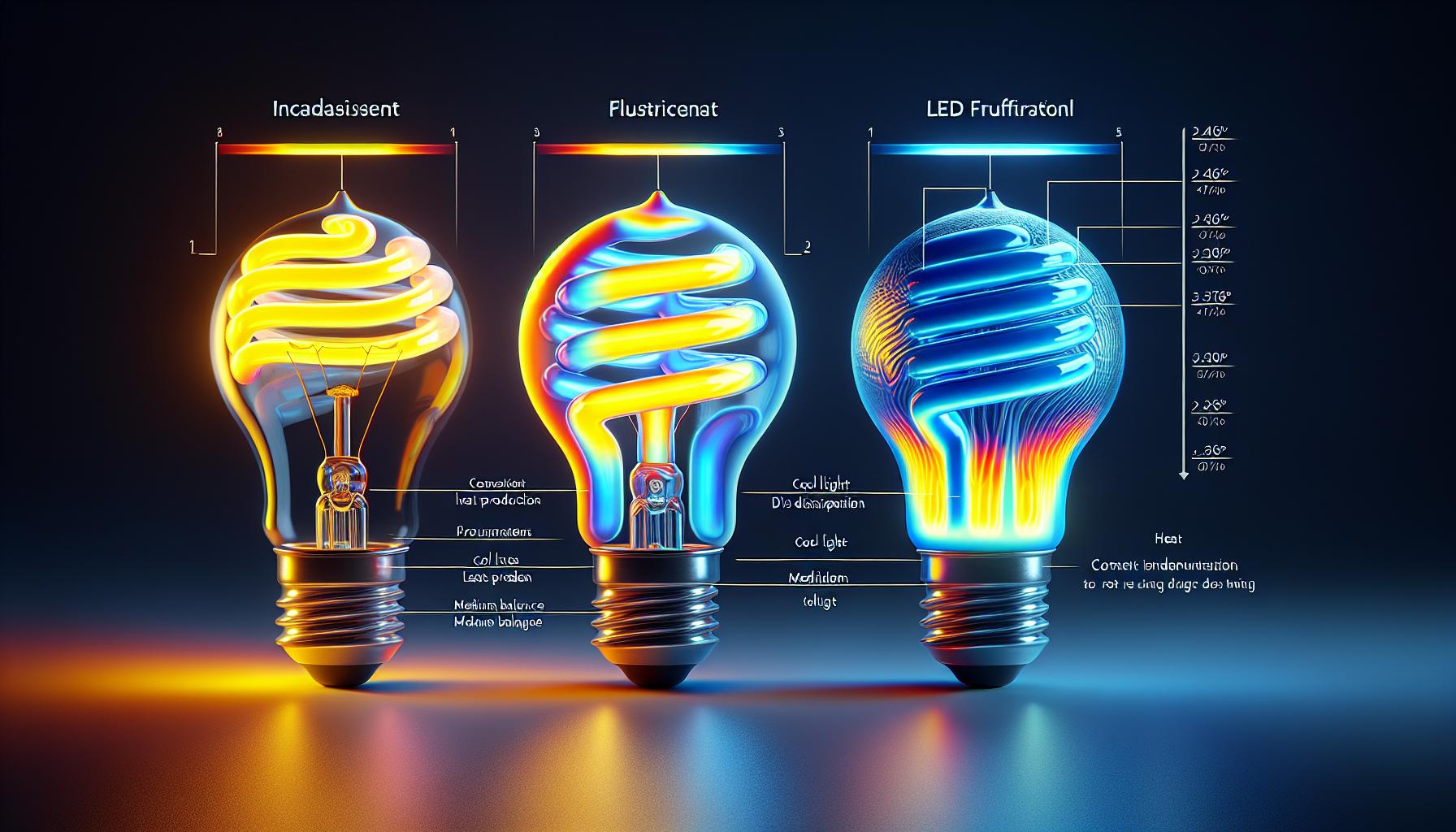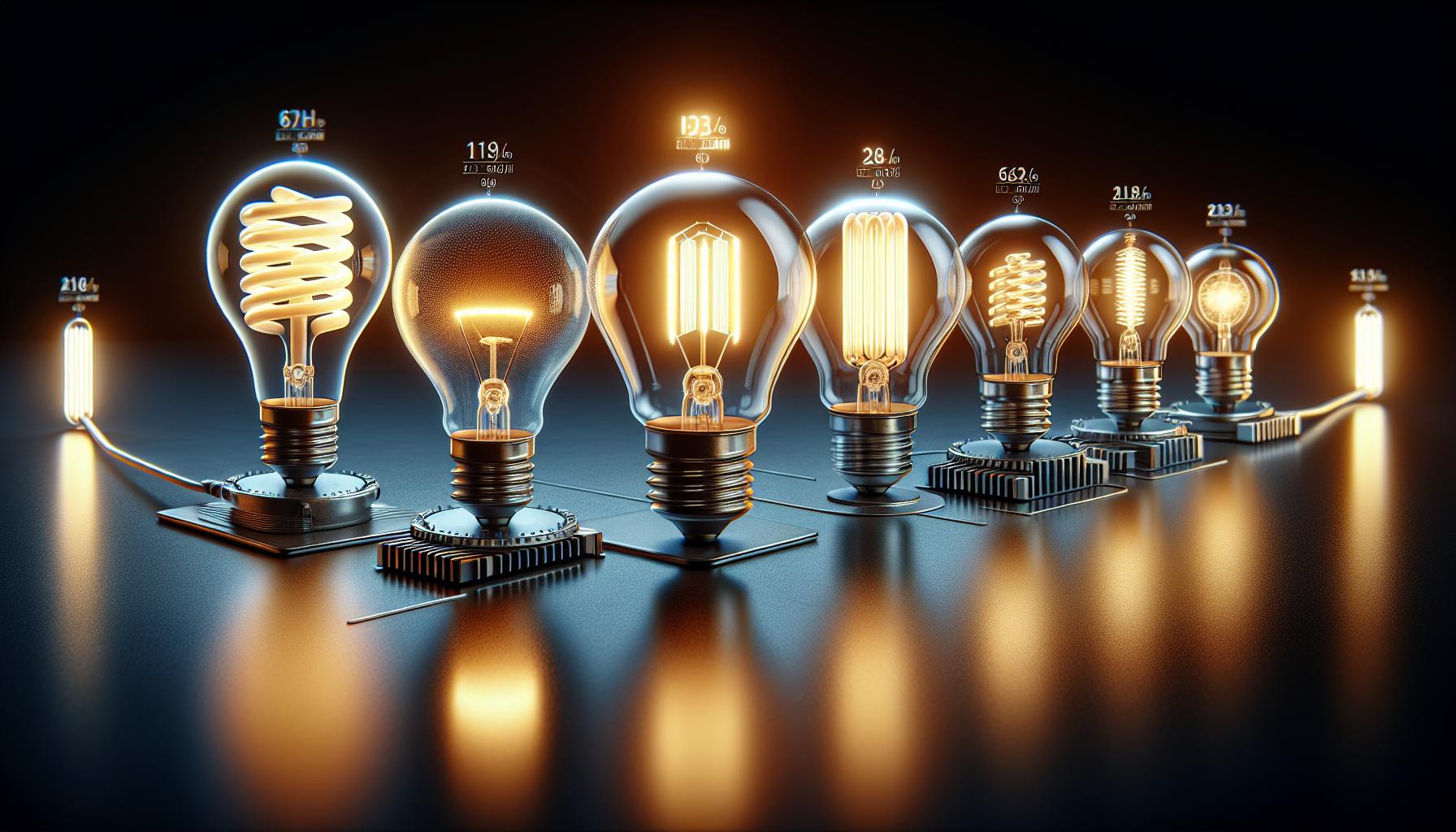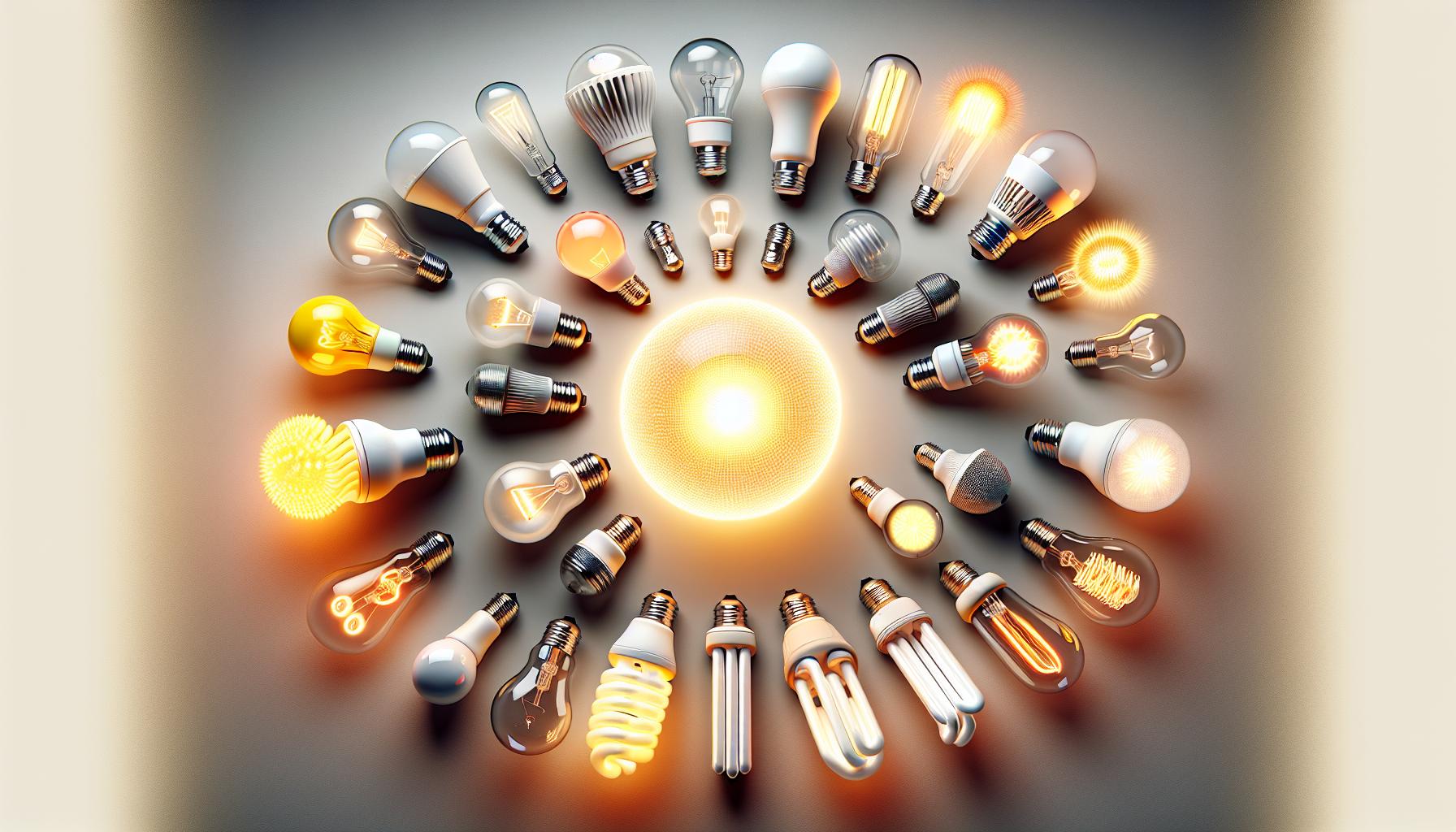Ever wondered why light bulbs can feel like tiny suns in your lampshade? You’re not alone. It’s a question that’s sparked curiosity since Edison’s day. The heat is not just an annoying byproduct; it’s a clue to how light bulbs work.
Dive into the science behind those glowing orbs in your home. You’ll discover why they turn electricity into heat and light, and why sometimes, they’re hotter than your morning coffee.
Understanding the heat of light bulbs isn’t just about solving a mystery—it’s also about safety and efficiency. Let’s shed some light on the subject and find out what’s really going on inside that glass bulb.
How do light bulbs produce light?
Delving into the heart of a light bulb’s functionality, you’ll find that it’s all about converting electricity into light. Incandescent bulbs, the traditional type you might’ve grown up with, pass electricity through a filament inside the bulb. As electricity flows, the filament, usually made from tungsten, resists the current and heats up to a point where it glows and produces light.
Here’s where it gets really interesting. This resistance and resultant heat is what causes the filament to reach incredibly high temperatures, often around 2,200 to 2,700 degrees Celsius (3,992 to 4,892 degrees Fahrenheit). The filament has to be encased in a glass bulb with an inert gas like argon to prevent it from burning up too quickly.
While incandescent bulbs are pretty straightforward, fluorescent and LED bulbs work somewhat differently. Fluorescent bulbs use a small amount of mercury vapor which produces ultraviolet light when electrified. This ultraviolet light, in turn, causes a phosphor coating on the inside of the bulb to glow, producing visible light.
LEDs, on the other hand, are more complex. They stand for Light Emitting Diodes and work by passing electricity through a semiconductor material. This causes the electrons in the semiconductor to move and release energy in the form of photons, which we see as light.
- Incandescent: Heat and light from filament
- Fluorescent: UV light converted to visible light
- LED: Electrons release photons
Since LEDs don’t rely on heating a filament, they stay much cooler than their incandescent counterparts. This not only makes them less of a burn hazard but also more energy-efficient since they are converting more of their energy directly into light without wasting as much on heat.
The role of heat in light bulb operation
Understanding why light bulbs get hot requires insight into the role of heat in their operation. Heat isn’t just a byproduct—it’s at the core of how traditional incandescent bulbs work. The filament inside the bulb, typically made of tungsten, needs to heat up to a high temperature to emit light. When you flick that switch, electricity flows through the filament, heating it up dramatically. It’s like a mini heater that provides light as a side benefit.
Fluorescent bulbs have a different approach, though they still produce some heat. The mercury vapor inside the tube is electrically excited, resulting in ultraviolet light. This UV light then interacts with the phosphor coating on the tube’s interior, converting it to visible light. While this process is more energy-efficient than its incandescent cousin, the conversion isn’t 100% efficient, leading to wasted energy in the form of heat.
LEDs are the tech-savvy member of the bulb family. They produce light through a process called electroluminescence. Electrons move through a semiconductor, releasing photons—light particles—as they go. This method is far more efficient, significantly reducing the amount of heat produced. However, even LEDs aren’t immune to heat. Proper heat dissipation is crucial for their operation and longevity, as high temperatures can shorten the lifespan of an LED. That’s why you’ll often find heat sinks and other cooling mechanisms in LED bulb designs.
As a home DIY enthusiast with a love for lighting projects, you’ll appreciate knowing that keeping your bulbs cool can extend their life. Whether it’s choosing the right fixture that allows for better airflow or opting for bulbs that are known to produce less heat, like LEDs, there’s always a way to blend efficiency with practicality. Remember, excessive heat not only affects the bulb’s life but can also be a hazard, so always ensure your lighting choices are both safe and strategic.
Why do light bulbs get so hot?
« Can You Use a Light Bulb with Less Watts? Unlock Efficient Lighting Secrets
What Is Best Light Bulb for Living Room? Illuminate with Top Picks »
When you’re immersed in a DIY home lighting project, understanding why light bulbs heat up can greatly influence your choices and help prevent any unwelcome surprises. Traditional incandescent bulbs have been brightening our homes for over a century, but they’re not the most efficient when it comes to energy use. Here’s why: About 90% of the energy they consume is emitted as heat rather than visible light. This is because the filament inside the bulb – typically made of tungsten – needs to become white-hot to generate light, a process inherently prone to wasted energy in the form of heat.
Fluorescent bulbs, although more efficient than incandescents, still grapple with the challenge of heat. In these bulbs, electricity excites mercury vapor, which in turn emits ultraviolet light. This ultraviolet light then causes the phosphor coating inside the tube to glow. Yet, this process is not without heat production. The initial excitement of the mercury vapor, along with the inevitable loss of some energy as heat, ensures that these bulbs stay warmer than you’d expect.
Moving onto LEDs, your go-to for efficiency, you’ll find a cooler operation, but not completely without heat. Although LEDs generate light through electroluminescence, which curbs the amount of heat produced, they aren’t exempt from the physics of heat generation. Any electrical device faces resistance, and with LEDs, this manifests as heat at the semiconductor junction. That’s why you’ll notice most LED bulbs have some form of a heat sink designed to manage and dissipate heat effectively.
In essence, whether you’re dealing with incandescent, fluorescent, or LED bulbs, the release of heat is an unavoidable byproduct of producing light. Your safety tip? Always ensure that your bulbs are the correct wattage for the fixture and that they’re not covered by anything that could restrict air flow and heat dissipation. Keep these facts in mind during your next lighting project and your bulbs will shine brighter and last longer.
Factors affecting the heat of light bulbs
As you dive deeper into the world of lighting, you’ll quickly realize that there’s more than meets the eye when it comes to why your light bulbs are getting hot. Several factors come into play, and understanding them can help troubleshoot excessive heat and even aid in selecting the right bulbs for your DIY projects.
Bulb Wattage
First off, the wattage of a bulb dictates how much electrical power it’s designed to use. Bulbs with higher wattages consume more electricity and typically generate more heat. So, if you’ve got a 100-watt bulb sitting snug in your reading lamp, it’s naturally going to run hotter than a 40-watt bulb.
Voltage
Another aspect to consider is the voltage in your electrical system. Standard voltage ratings may differ depending on where you are or the design of your lamp or fixture. If bulbs are exposed to higher voltages than they’re rated for, they’ll burn brighter and hotter and might meet an untimely end much quicker.
Ambient Temperature
The temperature around the bulb also plays a role. A light bulb in a cool basement won’t heat up as much as one in a cozy, warm attic room. This is why proper ventilation for fixtures is crucial, especially in tight spaces or enclosed recesses where hot air can accumulate.
Bulb Design
Bulb design, including the materials used for the enclosure and how the bulb dissipates heat, comes into the equation too. LEDs, for instance, use a heat sink to manage their lower, but still present, heat levels.
Usage Patterns
How frequently and for how long you leave your bulbs on will impact their heat output. Prolonged usage can lead to higher temperatures, which means it’s beneficial to turn off lights when they’re not needed, or consider smart bulbs that can be programmed and more easily managed.
Luminaire Construction
The fixture itself factors into the heat equation. A luminaire designed with good heat dissipation qualities will help in managing the bulb’s temperature. In contrast, those that lack airflow can trap heat, increasing the bulb’s temperature.
Safety concerns and efficiency considerations
When dealing with light bulbs, safety should be your top priority. Light bulbs that get too hot not only present a risk of burns upon touch but can also be a fire hazard. Understanding the variables that contribute to a light bulb’s temperature is crucial in mitigating these risks.
Incandescent bulbs, for example, convert only 10-20% of the energy they consume into light, with the rest being emitted as heat. It’s no surprise that these can become very hot during operation. On the other hand, LED bulbs are designed to be much more efficient, turning a larger portion of energy into light and thus giving off significantly less heat.
What’s often overlooked is how a bulb’s heat can impact the efficacy of lighting within a space. Excessive heat can shorten bulb lifespan, reducing efficiency over time. Not only does this mean you’ll be replacing bulbs more often, but it can also lead to a cycle of inefficiency and increased costs.
To promote both safety and efficiency, pay attention to how your lighting is installed. Ensure that fixtures have proper ventilation and are rated for the wattage of bulbs you’re using. It’s also wise to keep flammable materials well away from hot bulbs and to consider the use of a guard or shade to diffuse heat.
For the DIY enthusiast, exploring modern lighting solutions such as LEDs or CFLs (Compact Fluorescent Lamps) could be a rewarding project. These options not only operate at cooler temperatures but also consume less power, translating to a reduced risk of heat-related issues and better energy savings.
It’s clear that the heat of a light bulb is not just a matter of function but also ties into the larger framework of home lighting safety and efficiency. By making informed choices about the types of bulbs you use and understanding their heat output, you’re ensuring a well-lit, safe, and energy-conscious home.
Conclusion
You’ve seen how the heat from light bulbs is more than just a byproduct—it’s a sign of energy use and a potential safety concern. Remembering to handle them with care and considering the environment around your bulbs will keep you safe and could save energy. Whether you’re swapping out old bulbs for cooler, more efficient options or adjusting your usage habits, you’re now equipped to make informed choices. Stay bright and stay safe!
Frequently Asked Questions
What factors affect the heat generated by light bulbs?
Several factors contribute to the heat produced by light bulbs, including bulb wattage, voltage, the ambient temperature around the bulb, its design, how often and long it’s used, and the construction of the luminaire it’s housed in.
How does heat impact the safety of light bulbs?
Heat from light bulbs can create a safety hazard if the bulbs get too hot, potentially causing burns or increasing the risk of fire. It is essential to manage heat dissipation to maintain safety.
Can a light bulb’s heat affect its efficiency and lifespan?
Yes, the heat generated by a light bulb can influence its efficiency, with excessive heat potentially shortening the lifespan of the bulb. Efficient heat management can enhance both efficiency and longevity.
What are some ways to promote safety and efficiency regarding light bulb heat?
To ensure safety and efficiency, it is advised to have proper ventilation, use guards or shades to prevent direct contact with hot bulbs, and consider modern, cooler lighting options such as LEDs or CFLs.
Why is understanding light bulb heat output important for homeowners?
Understanding the heat output of light bulbs is essential for homeowners to maintain a well-lit and safe environment while also optimizing energy use and bulb lifespan.





